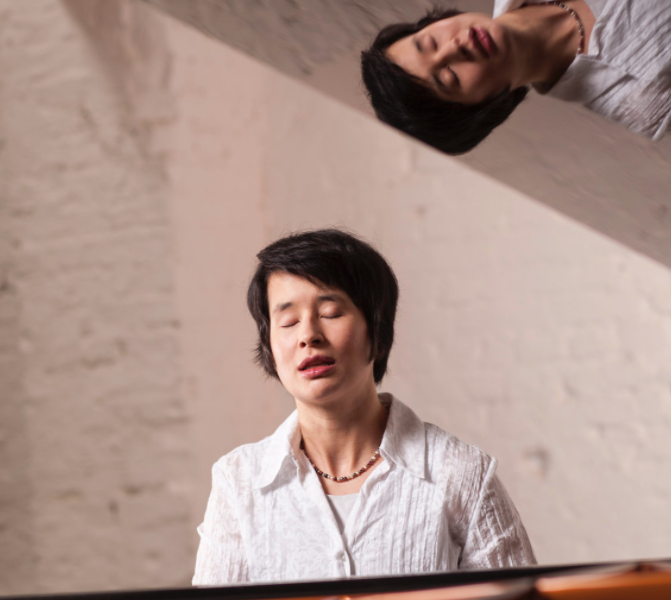Hemsing Associates presents Kimiko Ishizaka in Review
Kimiko Ishizaka, piano
Weill Recital Hall at Carnegie Hall, New York, NY
November 19, 2017
Kimiko Ishizaka gave an energetic, somewhat dry reading of Bach’s last work, Die Kunst der Fuge (The Art of the Fugue), further demonstrating her lifelong involvement with the master’s works. She has previously performed and recorded the “Goldberg” variations and Book I of the Well-Tempered Clavier.
She performed this gigantic series of fugues (referred to by the archaic term contrapunctus) and canons, all based on a single theme, from memory, an astonishing accomplishment, and she favored crisp touch, lots of détaché, generally brisk tempi, and absolutely no use of pedal. Andras Schiff also eschewed the pedal in his last presentation of the WTC at the 92nd Street Y a few years back, stating that although he had used it before, he preferred to find what he calls the “hand phrasing” that is only revealed when no pedal is used.
Now, I am an advocate of Bach on the modern piano, but if you’re going to use it, why deprive yourself of one of its principal resources? Of course, Baroque polyphony mustn’t “sound pedaled,” but the piano tone can be given much greater warmth and color variety with careful use.
I had that reservation about Ms. Ishizaka’s choices, as well as musical, dramatic, and philosophical reservations in general about this contrapuntal afternoon, as expertly played as it was. All Bach’s fugues and canons in this collection were written out in four-part open score, the standard for study—no instrumentation was ever specified. These were never intended for concert performance, or even private performance at one sitting, and though I enjoy hearing it that way, it simply lacked variety, mystery, a sense of the “sacred,” from which Bach’s entire oeuvre is never very far removed.
The most successful portion for me was, oddly, the four canons, in which her approach was perfectly united to the material. In the excellent program notes by Paul Griffiths, he mentions “creeping chromatic scale fragments” in one of the more complex fugues, but Ishizaka’s chromaticism lacked just that “creeping” quality, rather it danced, chirped, and just sounded busy.
Ms. Ishizaka also dared to complete the unfinished (projected quadruple) fugue. As Christoph Wolff points out, since combinatorial fugues like this are usually begun at the final, most complicated area, Bach had probably actually finished it (at least in his head) and was writing it out from the beginning when he died. That his death took place after the introduction of the third subject, the musical spelling of his own name (B-A-C-H is the German nomenclature for the notes Bb-C-A-B)), gave rise to generations of romanticization and speculation.
Completions are always a risk—none of us is J.S. Bach. Ms. Ishizaka’s while clever and not too lengthy, displayed more about Ms. Ishizaka than Bach, though she used many of the themes from previous fugues, and even a great reminder of the end of Contrapunctus I at the very end, thus coming full circle in a satisfying way. What her desire for completion tells me, however, is that perhaps she is uncomfortable with the mystery of just having it break off in midstream. Perhaps she has considered and rejected a “spiritual” approach to Bach, or perhaps this is her spiritual approach, but I can’t help wondering what a bit more legato and slightly slower tempi would have added to the music, even with no pedal.
Elsewhere, she had a few variant notes that I had learned differently, and altered rhythms, I’m sure intentional, in her incredible feat of precise memory. Contrapunctus IX was excellent in her hands, as were the two pairs of mirror fugues. The first eleven fugues were put in order by Bach himself. As for the rest, they were rather hastily cobbled together by C.P.E. Bach, his second son, for publication, hence some different accidentals, rhythms, etc, crept in.
Shortly after seeing to its publication, C.P.E. sold the engraver’s plates for the value of the metal—not too much respect to the “old wig,” as he called his father, whose style, sadly, was already superseded when he died. Paul Griffith mentioned that the modern premiere of the cycle was in Leipzig in 1927, in an orchestration by twenty-year-old Wolfgang Graeser. What he didn’t mention is that Graeser committed suicide right after the premiere. What Graeser’s friend, musicologist Erich Schwebsch said about it was “He took his life as one who, having penetrated through the mystery of life, no longer saw any need to continue therein.”
I’m almost apologetic about being so hard on such an obviously accomplished Bach pianist, but I do feel that there is much more that can be revealed in this monumental work. Ms. Ishizaka appears young, her stage presence is very upbeat, and as she lives with the work for years to come, I’m sure she will make ever-new discoveries.

